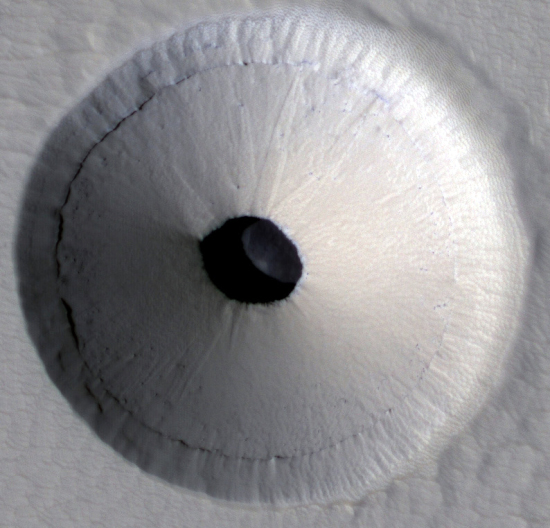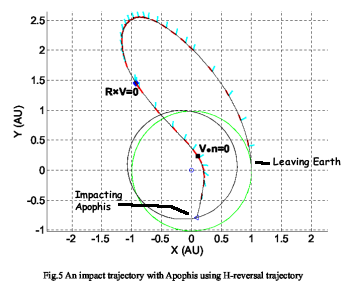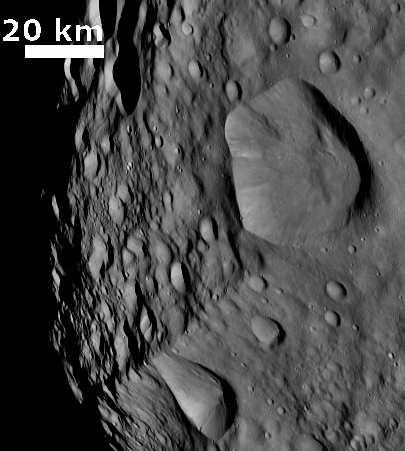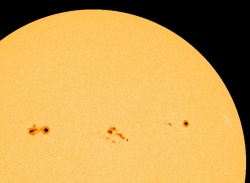The real inventor of the telegraph
An evening pause: In honor of the 100th anniversary of the sending of the first round-the-world telegram on August 20, 1911, here is the story of the real inventor of the telegraph. And it ain’t what you think.
An evening pause: In honor of the 100th anniversary of the sending of the first round-the-world telegram on August 20, 1911, here is the story of the real inventor of the telegraph. And it ain’t what you think.
A reindeer herder in Russia’s Arctic has stumbled on the pre-historic remains of a baby woolly mammoth.
Opportunity begins exploring the rim of Endeavour Crater, taking a bunch of new images . I especially like this one, of which I’ve posted a cropped scaled-down version below. The image looks across the 13-mile-wide Endeavour Crater to its far rim on the horizon. Note the haze. Mars very clearly has an atmosphere, even though it is far thinner than Earth’s. In the foreground are scattered rocks, ejecta produced from the impact that formed a smaller nearby crater now named Opportunity Crater.

The Pioneer anomaly is fading.
The analysis shows that the anomaly is not constant, as researchers had believed, but is decreasing with time. The finding points toward a conventional explanation of the phenomenon, most likely asymmetric radiation of heat, and against some of the more exotic proposals.
Archeologists reap treasures from a newly-discovered POW camp from the Civil War.
Camp Lawton’s obscurity helped it remain undisturbed all these years. Built about 50 miles south of Augusta, the Confederate camp imprisoned about 10,000 Union soldiers after it opened in October 1864 to replace the infamous Andersonville prison. But it lasted barely six weeks before Sherman’s army arrived and burned it during his march from Atlanta to Savannah.
Barely a footnote in the war’s history, Camp Lawton was a low priority among scholars. Its exact location was never verified. While known to be near Magnolia Springs State Park, archaeologists figured the camp was too short-lived to yield real historical treasures. That changed last year when Georgia Southern archaeology student Kevin Chapman seized on an offer by the state Department of Natural Resources to pursue his master’s thesis by looking for evidence of Camp Lawton’s stockade walls on the park grounds.
New research has shown that humans, not rats, spread the Black Death in the plague of 1348-1349. Also,
Sloane, who was previously a field archaeologist with the Museum of London, working on many medieval sites, is now attached to English Heritage. He has concluded that the spread of the 1348-49 plague, the worst to hit the capital, was far faster, with an impact far worse than had been estimated previously. While some suggest that half the city’s population of 60,000 died, he believes it could have been as high as two-thirds. Years later, in 1357, merchants were trying to get their tax bill cut on the grounds that a third of all property in the city was lying empty. [emphasis mine]
Time to start making your vacation plans. On August 21, 2017 a total eclipse of the sun is going to traverse the entire length of the continental United States, from Oregon to South Carolina. Kentucky will have the longest view, with totality as long as three minutes.
And astronomers are already thinking of ways to harness the help of the American people in observing this event. In a paper published today on the Los Alamos astro-ph website, a team of astronomers are proposing organizing something they have dubbed the U.S. Eclipse MegaMovie, whereby they gather together as many images of the totality as possible and assemble them into a single film, showing the evolution of the sun’s corona as it crosses the continent.
» Read more
The Titan Mare Explorer: A nautical mission to an alien sea.
If [NASA] green-lights the mission, the capsule will lift off in 2016. By 2023, TiME will be about 800 million miles away in Titan’s north-polar region, home to its biggest lakes and seas. The capsule will take photographs, collect meteorological data, measure depth, and analyze samples. TiME will have no means of propulsion once it is on Titan, so it will float, carried by breezes across the sea’s surface. Then, by the mid-2020s, it will enter a decade-long winter of darkness as the moon’s orbit takes it to the dark side of Saturn, away from the sun and communication. It won’t have a line of sight to Earth to beam back more data until 2035.
Mars Reconnaissance Orbiter has found another cave on Mars. The cropped version of the image, shown below, shows a remarkably symmetrical crater that probably has more similarities to sinkholes on earth. In the center is a 100 foot wide skylight into a cave. The crater is almost certainly formed partly by material dropping into the cave.


In a paper published today on the Los Alamos astro-ph preprint website, two Chinese scientists have proposed using a solar sail for deflecting any asteroid that happens to be aimed at the earth. The diagram to the right is their simulated mission to impact the asteroid Apophis, which will pass close to the earth in 2029 and — depending on whether that flyby puts it through a very small 600 meter-wide mathematical “keyhole” — could then return in 2036 on a collision course.
The idea is to use the sail to slow the spacecraft down enough so that it starts to fall towards the sun. The sail is then used to maneuver it into a retrograde orbit. When it impacts the asteroid the impact will therefore be similar to a head-on collision, thereby imputing the most energy in the least amount of time with the least amount of rocket fuel. In their Apophis simulation, a mission, weighing only 10 kilograms (about 22 pounds), launched around 2025, and hitting the asteroid in this manner in 2026, would deflect its flyby in 2029 enough to guarantee it will not fly through the “keyhole” and therefore eliminate any chance of it hitting the earth in 2036.
Obviously many questions must be answered before such a mission should fly.
» Read more
What caused a giant arrow-shaped cloud on Saturn’s moon Titan?
The Allen Telescope Array and the Search for Extraterrestial Intelligence (SETI) saved by private donations.

The images from Dawn keep rolling in. The picture on the right, released two days ago, shows the asteroid’s terminator. What makes it intriguing is the weird looking crater near the bottom of the image. It appears to have formed at impact on the wall of a cliff, something that at first glance seems impossible.
This is what I think happened: The impactor sliced down the wall of the cliff, but because of Vesta’s low gravitational field the impact scar never collapsed downward, filling in.
I once wrote an article about asteroids for Astronomy where I described these objects as having the consistency of mashed potatoes and ice cream sundaes. This image illustrates this nicely. The asteroid’s weak gravitational field limits the density of its material, so that puffy strange formations such as this crater can form.
Things are so good on Juno ten days after launch that mission controllers have canceled a rocket burn to adjust the spacecraft’s course.
Serious questions raised about the EPA process that designates a species as endangered.
Though it is not yet official, it appears the sun is blank of sunspots today, for the first time since January 16.
Solar scientists have concluded that the solar minimum of the past four years has ended and that the sun is now moving towards solar maximum. The recent activity in August has seemed to confirm this. However, once the minimum has ended, the sun should not have any further blank days until the maximum is over and the sun is ramping back down to solar minimum. That the sun should appear blank again during its ramp up to solar maximum is quite unusual, probably unprecedented, and is further evidence that the sun is heading towards a period of little or no solar activity.
The mystery of Vesta’s south pole depression.
Archeologists have discovered a 2,600-year-old wall mural used as a wall decoration during the Iron Age.
Here are some additional stories describing today’s test flight of the Hypersonic Test Vehicle.
I have several questions, and no answers:
The abuse of power: A legal rabbit farm raided and destroyed by Colorado police.
“They’ve destroyed me emotionally, socially and professionally,” Bell said, listing numerous ways in which local animal rights activists have publicized information about the case in an effort to make her and her four children — all adults who haven’t lived under her roof for several years — look bad. But that’s not all.
“They’ve made 4-H kids all across Colorado just sob,” she said, “because I am their 4-H connection.” Bell noted that 12 of the seized rabbits belong to 4-H kids who were planning to show them at upcoming fairs — two at the Jefferson County Fair that begins Thursday and the remaining 10 at the Colorado State Fair which runs from Aug. 26 to Sept. 5 in Pueblo.

Who needs aliens and imagined cities on the moon when you have a reality that produces such strange and beautiful things as the image on the right?
On July 2, the Hubble Space Telescope took this image of a planetary nebula, aptly dubbed the Necklace Nebula. As the caption explains,
A pair of stars orbiting close together produced the nebula, also called PN G054.2-03.4. About 10,000 years ago one of the aging stars ballooned to the point where it engulfed its companion star. The smaller star continued orbiting inside its larger companion, increasing the giant’s rotation rate.
The bloated companion star spun so fast that a large part of its gaseous envelope expanded into space. Due to centrifugal force, most of the gas escaped along the star’s equator, producing a ring. The embedded bright knots are dense gas clumps in the ring.
The binary still exists, and can be seen as the star in the center of the necklace. The two stars are now only a few million miles apart and complete an orbit around each other in about a day.
Japan has revised its tsunami warning system following the March 11 earthquake/tsunami.

As it does every month, NOAA’s Space Weather Prediction Center released today its monthly updated graph of the Sun’s solar cycle sunspot activity. I have posted the July graph below.
For the first time in four months there was a increase in sunspot activity, albeit small. The sun has been even more active in August, as shown by the flurry of sunspots on its face from August 1 (shown on the left) and the August 8 solar flare, the most powerful produced in four years.
This monthly graph, however, continues to suggest that the next solar maximum will be very very weak, even weaker than the most up-to-date predictions for the next solar maximum.

The sun unleashed its largest solar flare in years on Tuesday.
With the recently passed debt ceiling deal, there are going to be a lot of news reports talking about how that deal is going to force cuts and reductions in government spending. Everyone one of these stories will be a lie.
Take for example this story today in Nature, discussing the fate of science research under the deal. Here is how they describe what will happen if the Congressional “super-committee” cannot come up with an agreement and across-the-board “cuts” are triggered:
“Then there will be extraordinary pain,” says Michael Lubell, director of public affairs for the American Physical Society in Washington DC. “And it will get worse in 2014.”
The two-stage structure of the debt deal explains both the short-term reprieve and the long-term worry. The first set of agreed cuts, totalling US$917 billion, will be spread over 10 years, but two factors mitigate their effect. First, reductions to defence spending will account for a significant share of the cuts — meaning that other US agencies won’t bear the entire burden. Second, the cuts are heavily loaded forward onto the 2014 fiscal year and beyond, in an apparent effort to shelter the current fragile economy. Only minimal cuts will be implemented in fiscal years 2012 and 2013.
The trouble with this is that it is simply not true. There will be no cuts at all, under any condition, according the debt deal.
» Read more
A scientist is trying to grow arsenic-based life to prove or disprove the Mono Lake results, and describes her results day-by-day on her blog.
The science team for the rover Opportunity have released their first image taken from the rim of Endeavour Crater.
Since this picture looks south from Spirit Point less than a football field’s distance from the rim, it appears to look into the crater, the mountains on the right being the crater’s rim. What looks like a debris field running across the center of the image looks to me to be a combination of exposed patches of bedrock and boulders on the plateau above the rim. For the scientists, those boulders will be the prime research targets, as they are possibly ejecta produced at crater impact and could therefore be material thrown out from deep within the Martian crust.

Satellite data has confirmed that the March 11 Japanese tsunami caused icebergs to calf off the Sulzberger Ice Shelf in Antarctica.